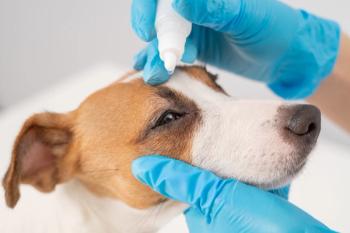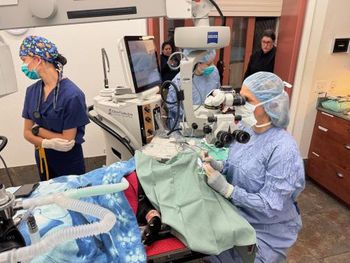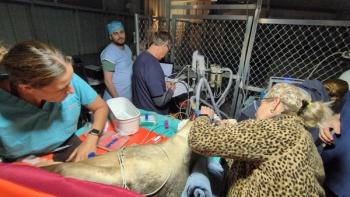
Basic ocular anatomy and diagnostics (Proceedings)
A review of the basic anatomy of the eye in dogs and cats.
Basic Anatomy of the Eye
- Orbit
- Eyelids
- Nasolacrimal System
- Cornea/Sclera
- Lens
- Uvea
- Aqueous/Vitreous
- Iridocorneal Angle
- Retina
- Optic Nerve & Brain
The Orbit
- Orbit= the "camera case" enclosing the eye
- Made of bone, ligament, fat, muscle, salivary gland, roof of mouth
- A mass behind the eye can push the eye out and/or protrude through soft tissue into the mouth*
The Eyelids
- Eyelids= "lens cover" or "windshield wipers" of the eye
- Act to protect and lubricate the surface of the eye
o Mechanical protection
o Meibomian glands of eyelids produce the oily component of the tears
o Spread tears (and foreign material) across surface & toward drainage system
- Outer layer is thin skin
- Muscles to close (orbicularis oculi) and open (levator palpebrae superioris) lids
- Poorly developed supportive tarsal plate in dogs/cats
- Meibomian glands in tarsus
- Inner surface lined with conjunctiva
- Cilia (eyelashes) arise from the lid margins*
- Eyelids= skin, so can get all the skin diseases
o Bacterial
o Parasitic
o Allergic
o Auto-Immune
o Neoplastic
- Eyelid glands can also become infected and/or inflamed, develop tumors
The Third Eyelid
- Most domestic species have some variation of this structure
- Acts to protect the eye when it is drawn over its surface passively*
- T-shaped cartilage core coated by conjunctiva
- Important tear-producing gland located behind and at its base
- Von Graefe or other atraumatic forceps are used to look behind the third eyelid for foreign bodies, follicles
The Nasolacrimal System
- Tear film coats cornea
o Meibomian glands produce thin fatty outer portion of tear film
o The lacrimal & third eyelid glands produce the thick middle watery tear layer
o Goblet cells within conjunctiva produce inner mucus layer
- After tear production, tears are flushed by lids toward upper & lower punctae
- Tears drain from lacrimal punctae→ canaliculi→ sac→ NL ducts→ nose/mouth
- Obstruction at any point causes failure of drainage (tearing)*
Cornea & Sclera
- Together make up the outer, fibrous coat of the eye
- CORNEA= clear "windshield" and most important focusing structure of eye
- SCLERA= the support mechanism
- CORNEA & SCLERA
- Cornea is a multilayered structure
- Pumps in the innermost endothelium (esp) and outermost epithelium act to dehydrate it
- The middle stroma is hydrophilic (water-loving)*
- CORNEA & SCLERA
- Corneal clarity achieved due to:
o Relative dehydration
o Lack of blood vessels
o Strict organization of collagen in stroma
- The sclera is opaque because it lacks these qualities
- Scarred cornea is also opaque to varying degrees b/c of fibrosis
The Lens
- LENS= "fine- focus" mechanism of eye
- Spherical structure responsible for focusing images on retina
- Similar to cornea, clarity achieved through:
o Relative dehydration
o Acellularity
o Lack of blood vessels
- Production of new lens fibers occurs only from anterior lens epithelium
- Individual lens fibers do not reach all the way around; where they meet is staggered, forming lens sutures
o Y-shaped in dog/cat
- Cells lose organelles with maturity
- Layers added consecutively throughout life ("onionskin")
o Volume stays same, so compression of inner layers occurs with age
o Oldest layers are innermost
- Normal lens held in place by numerous peripheral lens zonules
- When all zonules rupture, lens luxation occurs
- Without a lens, near images appear
o Out of focus
o Larger than life
The Uvea
- Pigmented & highly vascular middle coat of eye
- Three segments
o Iris
o Ciliary body
o Choroid
- Iris and CB= anterior uvea
- Because of its intense vascularity, uvea sensitive to systemic inflammation and infections
- A blood-aqueous barrier (BAB) is intended to dampen this response, but can be broken down and takes months or longer to re-establish
The Uvea- Iris
- Iris= pigmented "sunshade"
- Pupil is "aperture"
o Controls amount of light entering eye
- Pupil shape differs with species
The Uvea- Ciliary Body
- Ciliary body= Aqueous-producing factory
- Target of IOP-lowering drugs and procedures which reduce aqueous production
o Methazolamide
o Trusopt
o Laser CPC
o Cryoablation
o Gentocin injection
The Uvea- Aqueous Humor
- Aqueous is normally clear liquid
- Fills anterior & posterior chambers
- Normally low in protein
o Increase in protein content with BAB breakdown (seen as aqueous flare)
- Drains through iridocorneal angle
The Uvea- Choroid
- Blood and oxygen supply to the retina
o Exclusive supply to some species' retinas
- Located between visual retina and supportive sclera
- Contains reflective tapetum
Vitreous
- Vitreous is normally gelled and fills vitreous chamber between lens and retina
- Even degenerated vitreous held in back of eye by intact lens zonules*
- Places pressure on neuroretina to help keep it in place
o Vitreal degeneration may result from or predispose to retinal detachment
The Iridocorneal Angle
- IRIDOCORNEAL ANGLE= the eye's "drain"
- If this is abnormally formed or damaged, drainage occurs less freely and intraocular pressure builds up→ glaucoma
The Retina
- RETINA= the "film" in the "camera"
- Responsible for converting light energy into chemical energy and passing it as a neuro signal to the brain
- Ten layered structure
o 9 layers of neuroretina
o Outer retinal pigment epithelium (RPE)
o Reflective tapetum actually within choroid
o Retinal detachment not entirely accurate term, since separation occurs b/w neuroretina and RPE
The Retina-the Cells
- Photoreceptors
o "rods" and "cones"
o Absorb incoming light
o Narrow range of specific wavelengths absorb by each cone- varies by species
- Bipolar cells connect PRs to...
- Retinal ganglion cells
- RGCs converge to ON
Optic Nerve & Brain
- OPTIC NERVE= "cable" connecting the eye to the "computer" (BRAIN)
- The optic nerve is the only nerve in the body that can be directly examined (by ophthalmoscopy)
- If the ophthalmic exam and ERG are normal, blindness must be secondary to a ON or brain problem
- The nerve is a collection of axons of the retinal photoreceptors
- Takes visual message to the brain
o Travels through weak point in sclera called lamina cribrosa
o Padded in orbit by fat
- Passes thru the optic foramen
- Considered cranial nerve II
- Brain is responsible for interpreting the signal from the eye so that it forms a meaningful image
- Damage to the occipital or "visual cortex" can result in blindness even if the eye is completely normal
Newsletter
From exam room tips to practice management insights, get trusted veterinary news delivered straight to your inbox—subscribe to dvm360.




